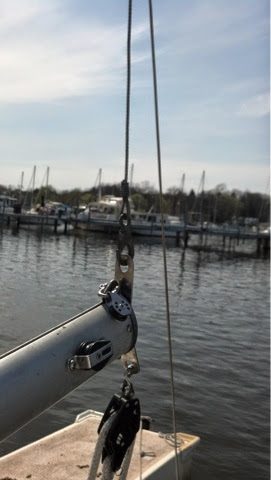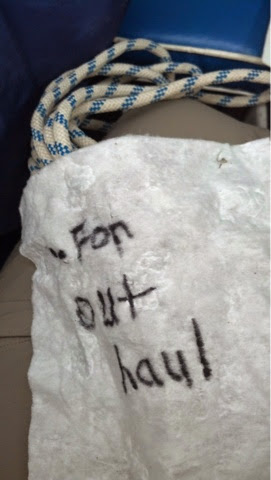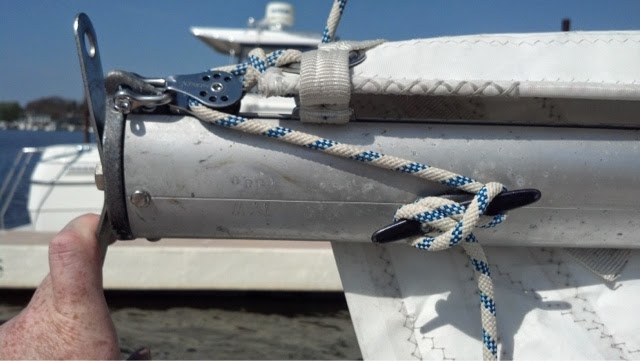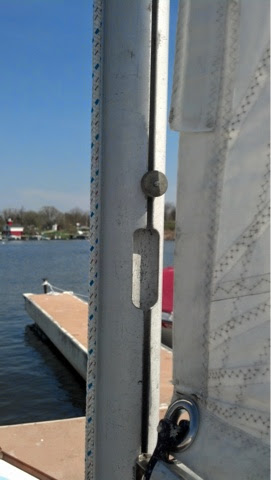Main sail rigging
This post is a quick reference for rigging the main sail of a Cape Dory Typhoon. Each boat over time has different modifications made to it based on the skippers preferences so your boat may not be exactly like this one. However this is how I put mine together.
I first start with tuning the mast in. I like to have a bit of rake in the mast and to be sure that it is in column.
Next I slide the booms goose neck into the mast.
I slide the boom down to the sail stop and make sure it is tight with a screw driver.
Then I clip the back side of the boom to the back stay catch.
After that I get to work on untwisting the main sheet.
My current main sheet set up goes something like this. It is a bit of a variation from the original set up. You can see I still use one of the original Schafer stand up blocks to guide the sheet line to the cam cleat but the Harken fiddle block does most of the heavy lifting here. Later this season I'm hopping to switch this system out for a traveler.
Next I run my topping lift. In this case, the topping lift is anchored at the top of the mast. It runs through a check block mounted to the back of the boom. The line is tied off about halfway up the boom so you never half to leave the tiller to adjust it. The only disadvantage to this system is you have to remove it if you use the roller reefer built into the boom. One of my main sails has to be roller reefed the others have benzels built into the sails so this isn't really an issue for me.
Now it's time to lay out some canvas. For the early spring I put on one of my older mains. It is a sail loft built sail and is heavily built; a great sail for our early, breezy, spring weather. Later in the season, I will switch to my oversized sailrite main. I slide the foot sail slides onto the boom.
Then I latch the tack into the boom. This particular sail is a tight fit and takes some persuasion with the blunt end of a screw driver to get it in.
I found this napkin down below. Last season I must have trashed out my out haul line and found a replacement line in my scraps. It's always good to leave yourself notes at the end of a season.
So here's the out haul rigged up. Clew to block to cleat: pretty straight forward. This is also a good time to put the battens in your sail if you have not already done so.
Next comes the fun part. Hook up he halyard and begin running the sail up the mast placing the sail slides in the track as you go.
Once the sail is raised all the way to the top of the mast I cleat it off and set the sail slide in place.
Finally I check the down haul line and give the sail a pull down to take out the wrinkles.
We are ready for our first sail of the season. Chime in if you rig your Typhoon differently. I know some of my rig is a bit unorthodox but, it works great for me. I'm always looking for ways to improve my rig and would love to hear what others are doing differently.
















Chris, that is an informative slide show on mainsail rigging. Agree that rigging takes on various aspects for preferences. I noted with interest your alteration on the aft for the mainsheet. I'm thinking of going with Bristol Bronze's option to replace the cam cleat. Still thinking on that. Plus, I noted your bronze bow plate looks splendid!
ReplyDeleteThanks, William I'm hoping to change the whole main sheet system out soon. I have most of the parts but I'm still watching ebay for the last few things I need. I want to have all the control lines centralized so I can still lean back and relax with out getting poked in the back by a cam cleat.
DeleteIm thinking of adding a topping lift to my Ty but am unclear as to how attach a block to the masthead so that it doesn't interfere with the back stay or main halyard? How did you do this?
ReplyDeleteThx
Paul
Paul sorry I just saw this. I do not have a block at the top of my mast. At the top it is simply tied in with the back stay I likely used a bowline. I have a block down on the aft of the boom to do all my back stay adjustments from the cockpit. Works nicely I never have to leave the tiller. Sorry I didn't see this earlier.
DeleteI found your slideshow on rigging a Cape Dory Typhoon very useful. I have a question regarding tuning the mast. We recently bought a 1967 Cape Dory Typhoon Weekender and we would like to set the shroud tension using a shroud tension meter. Would you happen to know where we could find what the correct tension should be for an 18th inch shroud--the tension numbers are not in the manual that we have. Any pointers you have would be appreciated!
ReplyDeleteGlad you liked the slides. I do not know specific numbers for tensioning the mast shrouds. I always do it by eye. Just making sure the mast is in column and then rake it back with some tension on the back stay.
ReplyDeleteNice Typhoon slides; question about standard rake for a Typhoon mast. I noticed this season, once the boat went into the water, there appears to be a lot of rake that I didn't see in the past. I kinda, think the rigging was done a land and then in the water the boat settled at a different angle. The rigger says Typhoons have a pronounced rake. Is this true? Photos i see of Typhoons have straight up masts.
ReplyDeleteRake is really a preference you can adjust your back stay and fore stay to get more or less. I always put a lot of rake in my Typhoon to try to compensate for the full keel when going to windward.
Delete